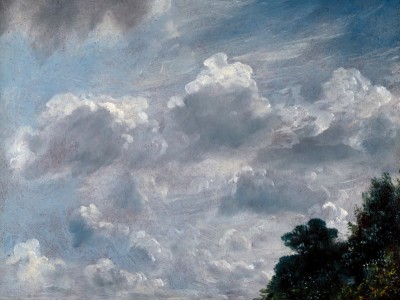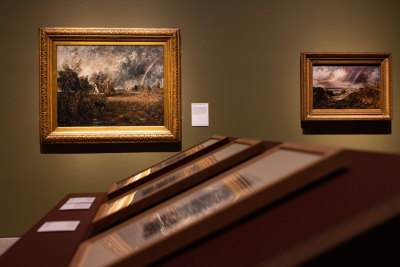Artist of the month: October 2014
Artist of the month: October 2014
John Constable RA
By the RA Collections team
Published 1 October 2014
Inspired by nature, John Constable RA brought landscape art into the public eye at a time when portraiture and historical subjects were much more widely esteemed.
-
Along with his contemporary and fellow Royal Academician J.M.W. Turner, John Constable raised the profile of landscape painting at a time when the public and the art establishments preferred portraiture and historical subjects. Constable was dedicated to painting nature. He made hundreds of sketches direct from nature and imbued his studio paintings with a feeling of open-air spontaneity.
-

John Constable RA, Rainstorm Over the Sea, c. 1824 - 1828.
Oil on paper laid on canvas. 23.5 x 32.6 cm. © Royal Academy of Arts, London.
-
This sketch was painted in Brighton. Constable’s wife Maria contracted tuberculosis in 1819 and from 1824 the couple frequented Brighton hoping that the sea air would improve her health. Constable claimed to dislike the crowded town calling it “Piccadilly by the sea-side”. Nevertheless, he made some of his most striking open-air studies there by balancing his paint-box on his knees and sketching on paper placed in its lid. Constable delighted in capturing changing weather conditions, especially storms, which challenged him to make dramatic studies at speed. Here the thunderous black clouds and torrential downpour have been painted rapidly to capture the fleeting nature of the scene.
In 1819 Constable embarked upon a series of large six-foot canvases with the aim of making his reputation as a serious landscape painter. The Leaping Horse is from this series and depicts a tow horse jumping one of the barriers erected along the path by the River Stour to prevent cattle from straying. The Stour was an important source of inspiration for Constable. He said “Painting is another word for feeling. I associate my ‘careless boyhood’ to all that lies on the banks of the Stour. They made me a painter (& I am gratefull [sic]) that is I had often thought of pictures of them before I had even touched a pencil.”
-

John Constable RA, The Leaping Horse, 1825.
Oil on canvas. 142 x 187.3 cm. Royal Academy of Arts, London. Given by Mrs Dawkins 1889. Photo © Royal Academy of Arts, London; photographer: Prudence Cuming Associates Limited.
-
Begun in 1825, Constable described the painting in a letter, as “a lovely subject, of the canal kind, lively - & soothing - calm and exhilarating, fresh - & blowing”. The painting was exhibited at the Royal Academy in 1825 but remained unsold. Constable then altered the composition by painting over an old willow stump which was in front of the horse, although a faint trace of the tree can still be seen. The removal of the willow stump and the addition of the half-furled sail on the barge gave the composition greater strength and direction by concentrating the eye on the dramatic leap of the horse.
The painting was worked up from sketches but still has the appearance of being hastily applied. Dashes of pure colour and vivid highlights help to convey the atmosphere of a blustery day.
-

John Constable RA, Cloud Study, 11 September 1821.
Oil on paper laid on board. 24.1 x 29.9 cm. Royal Academy of Arts, London. Given by Isabel Constable 1888. Photo © Royal Academy of Arts, London; photographer: John Hammond.
-
When Constable moved to London he was not attracted to the formality of city parks and said “a gentleman’s park is my aversion. It is not beauty because it is not nature”. To escape urban artifice he looked to the wilder terrain of Hampstead Heath and the skies above it. This sketch was painted in the open air on an autumn morning. Constable often made notes on the reverse of his sketches, which underline his analytical observation of weather conditions. In this instance:
“Hampstead, Sept 11, 1821. 10 to 11 morning under the sun - Clouds silvery grey on warm ground sultry. Light wind to the S.W. fine all day - but rain in the night following.”
Constable was elected a Royal Academician on 10 February 1829. Although he had at least three major works in his possession, he decided that he wanted to deposit A Boat Passing a Lock as his Diploma work. The owner of the painting, a friend, James Carpenter, agreed to return the picture to Constable on the condition he received a replacement, preferably a scene of Hampstead Heath. Unfortunately Carpenter never did receive a new painting.
-

John Constable RA, A Boat Passing a Lock, 1826.
Oil on canvas. 101.60 x 127.0 cm. © Royal Academy of Arts, London; Photographer: Prudence Cuming Associates Limited.
-
Constable’s The Leaping Horse and Rainstorm over the Sea can be seen until 11 January 2015 in Constable: The Making of a Master at the Victoria and Albert Museum.
Constable’s Boat Passing a Lock can be seen at the Tokyo Fuji Art Museum until 24 November as part of the Royal Academy Collection touring exhibition Genius and Ambition, The Royal Academy of Arts, London 1768-1918.
See more works by John Constable RA in our Collection.







